Hao Tang
VaseVQA-3D: Benchmarking 3D VLMs on Ancient Greek Pottery
Oct 06, 2025Abstract:Vision-Language Models (VLMs) have achieved significant progress in multimodal understanding tasks, demonstrating strong capabilities particularly in general tasks such as image captioning and visual reasoning. However, when dealing with specialized cultural heritage domains like 3D vase artifacts, existing models face severe data scarcity issues and insufficient domain knowledge limitations. Due to the lack of targeted training data, current VLMs struggle to effectively handle such culturally significant specialized tasks. To address these challenges, we propose the VaseVQA-3D dataset, which serves as the first 3D visual question answering dataset for ancient Greek pottery analysis, collecting 664 ancient Greek vase 3D models with corresponding question-answer data and establishing a complete data construction pipeline. We further develop the VaseVLM model, enhancing model performance in vase artifact analysis through domain-adaptive training. Experimental results validate the effectiveness of our approach, where we improve by 12.8% on R@1 metrics and by 6.6% on lexical similarity compared with previous state-of-the-art on the VaseVQA-3D dataset, significantly improving the recognition and understanding of 3D vase artifacts, providing new technical pathways for digital heritage preservation research.
Policy Gradient Guidance Enables Test Time Control
Oct 02, 2025Abstract:We introduce Policy Gradient Guidance (PGG), a simple extension of classifier-free guidance from diffusion models to classical policy gradient methods. PGG augments the policy gradient with an unconditional branch and interpolates conditional and unconditional branches, yielding a test-time control knob that modulates behavior without retraining. We provide a theoretical derivation showing that the additional normalization term vanishes under advantage estimation, leading to a clean guided policy gradient update. Empirically, we evaluate PGG on discrete and continuous control benchmarks. We find that conditioning dropout-central to diffusion guidance-offers gains in simple discrete tasks and low sample regimes, but dropout destabilizes continuous control. Training with modestly larger guidance ($\gamma>1$) consistently improves stability, sample efficiency, and controllability. Our results show that guidance, previously confined to diffusion policies, can be adapted to standard on-policy methods, opening new directions for controllable online reinforcement learning.
Towards Better Dental AI: A Multimodal Benchmark and Instruction Dataset for Panoramic X-ray Analysis
Sep 11, 2025



Abstract:Recent advances in large vision-language models (LVLMs) have demonstrated strong performance on general-purpose medical tasks. However, their effectiveness in specialized domains such as dentistry remains underexplored. In particular, panoramic X-rays, a widely used imaging modality in oral radiology, pose interpretative challenges due to dense anatomical structures and subtle pathological cues, which are not captured by existing medical benchmarks or instruction datasets. To this end, we introduce MMOral, the first large-scale multimodal instruction dataset and benchmark tailored for panoramic X-ray interpretation. MMOral consists of 20,563 annotated images paired with 1.3 million instruction-following instances across diverse task types, including attribute extraction, report generation, visual question answering, and image-grounded dialogue. In addition, we present MMOral-Bench, a comprehensive evaluation suite covering five key diagnostic dimensions in dentistry. We evaluate 64 LVLMs on MMOral-Bench and find that even the best-performing model, i.e., GPT-4o, only achieves 41.45% accuracy, revealing significant limitations of current models in this domain. To promote the progress of this specific domain, we also propose OralGPT, which conducts supervised fine-tuning (SFT) upon Qwen2.5-VL-7B with our meticulously curated MMOral instruction dataset. Remarkably, a single epoch of SFT yields substantial performance enhancements for LVLMs, e.g., OralGPT demonstrates a 24.73% improvement. Both MMOral and OralGPT hold significant potential as a critical foundation for intelligent dentistry and enable more clinically impactful multimodal AI systems in the dental field. The dataset, model, benchmark, and evaluation suite are available at https://github.com/isbrycee/OralGPT.
MoCo: Motion-Consistent Human Video Generation via Structure-Appearance Decoupling
Aug 24, 2025Abstract:Generating human videos with consistent motion from text prompts remains a significant challenge, particularly for whole-body or long-range motion. Existing video generation models prioritize appearance fidelity, resulting in unrealistic or physically implausible human movements with poor structural coherence. Additionally, most existing human video datasets primarily focus on facial or upper-body motions, or consist of vertically oriented dance videos, limiting the scope of corresponding generation methods to simple movements. To overcome these challenges, we propose MoCo, which decouples the process of human video generation into two components: structure generation and appearance generation. Specifically, our method first employs an efficient 3D structure generator to produce a human motion sequence from a text prompt. The remaining video appearance is then synthesized under the guidance of the generated structural sequence. To improve fine-grained control over sparse human structures, we introduce Human-Aware Dynamic Control modules and integrate dense tracking constraints during training. Furthermore, recognizing the limitations of existing datasets, we construct a large-scale whole-body human video dataset featuring complex and diverse motions. Extensive experiments demonstrate that MoCo outperforms existing approaches in generating realistic and structurally coherent human videos.
TSLA: A Task-Specific Learning Adaptation for Semantic Segmentation on Autonomous Vehicles Platform
Aug 17, 2025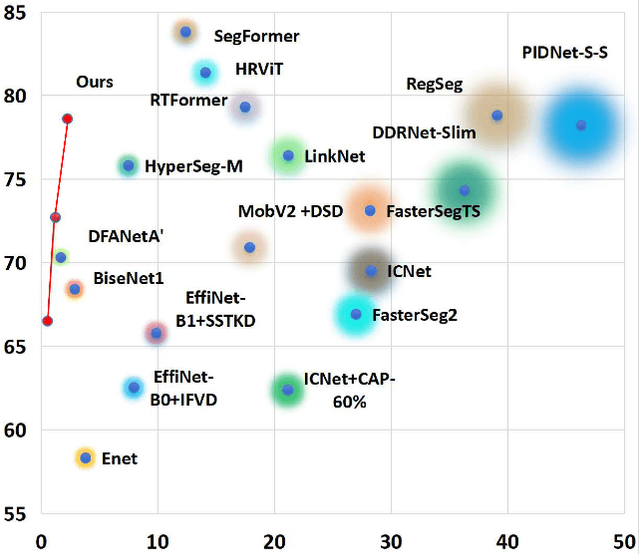
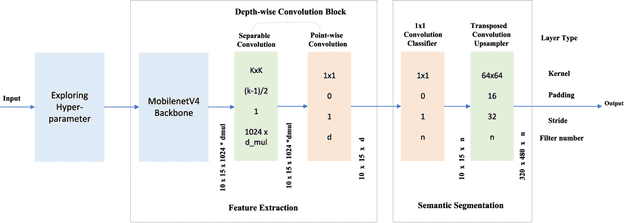
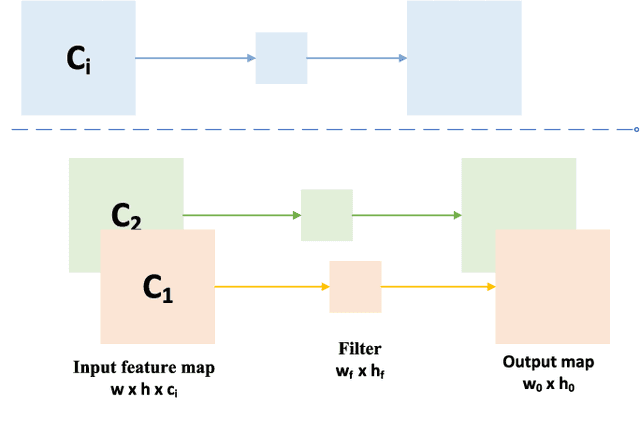
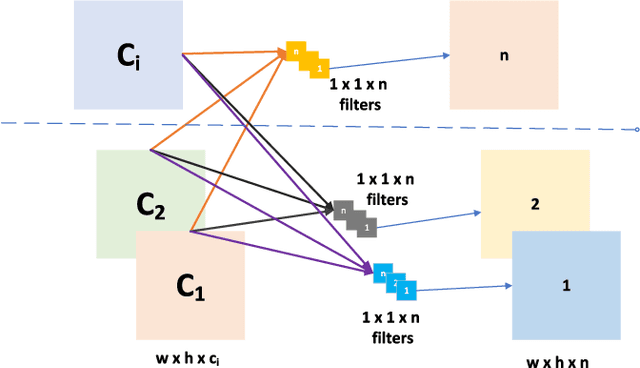
Abstract:Autonomous driving platforms encounter diverse driving scenarios, each with varying hardware resources and precision requirements. Given the computational limitations of embedded devices, it is crucial to consider computing costs when deploying on target platforms like the NVIDIA\textsuperscript{\textregistered} DRIVE PX 2. Our objective is to customize the semantic segmentation network according to the computing power and specific scenarios of autonomous driving hardware. We implement dynamic adaptability through a three-tier control mechanism -- width multiplier, classifier depth, and classifier kernel -- allowing fine-grained control over model components based on hardware constraints and task requirements. This adaptability facilitates broad model scaling, targeted refinement of the final layers, and scenario-specific optimization of kernel sizes, leading to improved resource allocation and performance. Additionally, we leverage Bayesian Optimization with surrogate modeling to efficiently explore hyperparameter spaces under tight computational budgets. Our approach addresses scenario-specific and task-specific requirements through automatic parameter search, accommodating the unique computational complexity and accuracy needs of autonomous driving. It scales its Multiply-Accumulate Operations (MACs) for Task-Specific Learning Adaptation (TSLA), resulting in alternative configurations tailored to diverse self-driving tasks. These TSLA customizations maximize computational capacity and model accuracy, optimizing hardware utilization.
RCR-Router: Efficient Role-Aware Context Routing for Multi-Agent LLM Systems with Structured Memory
Aug 06, 2025Abstract:Multi-agent large language model (LLM) systems have shown strong potential in complex reasoning and collaborative decision-making tasks. However, most existing coordination schemes rely on static or full-context routing strategies, which lead to excessive token consumption, redundant memory exposure, and limited adaptability across interaction rounds. We introduce RCR-Router, a modular and role-aware context routing framework designed to enable efficient, adaptive collaboration in multi-agent LLMs. To our knowledge, this is the first routing approach that dynamically selects semantically relevant memory subsets for each agent based on its role and task stage, while adhering to a strict token budget. A lightweight scoring policy guides memory selection, and agent outputs are iteratively integrated into a shared memory store to facilitate progressive context refinement. To better evaluate model behavior, we further propose an Answer Quality Score metric that captures LLM-generated explanations beyond standard QA accuracy. Experiments on three multi-hop QA benchmarks -- HotPotQA, MuSiQue, and 2WikiMultihop -- demonstrate that RCR-Router reduces token usage (up to 30%) while improving or maintaining answer quality. These results highlight the importance of structured memory routing and output-aware evaluation in advancing scalable multi-agent LLM systems.
ICM-Fusion: In-Context Meta-Optimized LoRA Fusion for Multi-Task Adaptation
Aug 06, 2025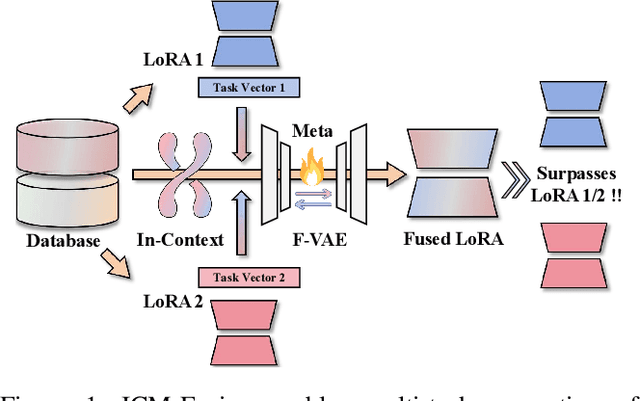
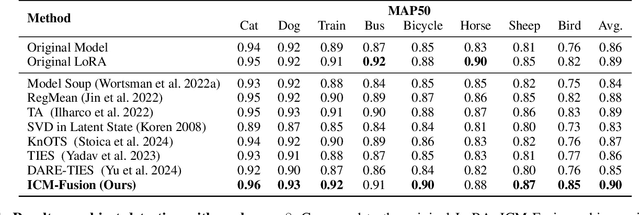
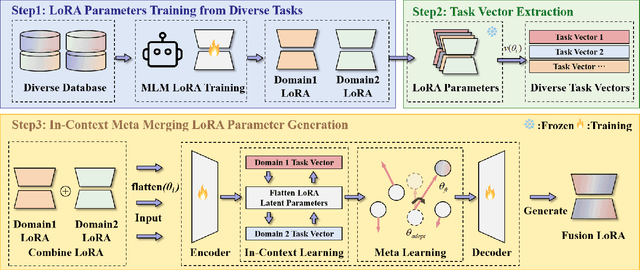
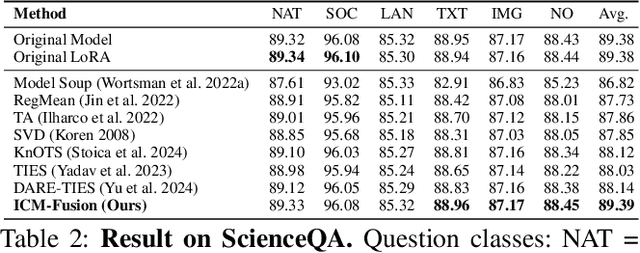
Abstract:Enabling multi-task adaptation in pre-trained Low-Rank Adaptation (LoRA) models is crucial for enhancing their generalization capabilities. Most existing pre-trained LoRA fusion methods decompose weight matrices, sharing similar parameters while merging divergent ones. However, this paradigm inevitably induces inter-weight conflicts and leads to catastrophic domain forgetting. While incremental learning enables adaptation to multiple tasks, it struggles to achieve generalization in few-shot scenarios. Consequently, when the weight data follows a long-tailed distribution, it can lead to forgetting in the fused weights. To address this issue, we propose In-Context Meta LoRA Fusion (ICM-Fusion), a novel framework that synergizes meta-learning with in-context adaptation. The key innovation lies in our task vector arithmetic, which dynamically balances conflicting optimization directions across domains through learned manifold projections. ICM-Fusion obtains the optimal task vector orientation for the fused model in the latent space by adjusting the orientation of the task vectors. Subsequently, the fused LoRA is reconstructed by a self-designed Fusion VAE (F-VAE) to realize multi-task LoRA generation. We have conducted extensive experiments on visual and linguistic tasks, and the experimental results demonstrate that ICM-Fusion can be adapted to a wide range of architectural models and applied to various tasks. Compared to the current pre-trained LoRA fusion method, ICM-Fusion fused LoRA can significantly reduce the multi-tasking loss and can even achieve task enhancement in few-shot scenarios.
Spatial-Temporal Graph Mamba for Music-Guided Dance Video Synthesis
Jul 09, 2025



Abstract:We propose a novel spatial-temporal graph Mamba (STG-Mamba) for the music-guided dance video synthesis task, i.e., to translate the input music to a dance video. STG-Mamba consists of two translation mappings: music-to-skeleton translation and skeleton-to-video translation. In the music-to-skeleton translation, we introduce a novel spatial-temporal graph Mamba (STGM) block to effectively construct skeleton sequences from the input music, capturing dependencies between joints in both the spatial and temporal dimensions. For the skeleton-to-video translation, we propose a novel self-supervised regularization network to translate the generated skeletons, along with a conditional image, into a dance video. Lastly, we collect a new skeleton-to-video translation dataset from the Internet, containing 54,944 video clips. Extensive experiments demonstrate that STG-Mamba achieves significantly better results than existing methods.
ScoreAdv: Score-based Targeted Generation of Natural Adversarial Examples via Diffusion Models
Jul 08, 2025Abstract:Despite the success of deep learning across various domains, it remains vulnerable to adversarial attacks. Although many existing adversarial attack methods achieve high success rates, they typically rely on $\ell_{p}$-norm perturbation constraints, which do not align with human perceptual capabilities. Consequently, researchers have shifted their focus toward generating natural, unrestricted adversarial examples (UAEs). GAN-based approaches suffer from inherent limitations, such as poor image quality due to instability and mode collapse. Meanwhile, diffusion models have been employed for UAE generation, but they still rely on iterative PGD perturbation injection, without fully leveraging their central denoising capabilities. In this paper, we introduce a novel approach for generating UAEs based on diffusion models, named ScoreAdv. This method incorporates an interpretable adversarial guidance mechanism to gradually shift the sampling distribution towards the adversarial distribution, while using an interpretable saliency map to inject the visual information of a reference image into the generated samples. Notably, our method is capable of generating an unlimited number of natural adversarial examples and can attack not only classification models but also retrieval models. We conduct extensive experiments on ImageNet and CelebA datasets, validating the performance of ScoreAdv across ten target models in both black-box and white-box settings. Our results demonstrate that ScoreAdv achieves state-of-the-art attack success rates and image quality. Furthermore, the dynamic balance between denoising and adversarial perturbation enables ScoreAdv to remain robust even under defensive measures.
Learning to Reason Across Parallel Samples for LLM Reasoning
Jun 10, 2025Abstract:Scaling test-time compute brings substantial performance gains for large language models (LLMs). By sampling multiple answers and heuristically aggregate their answers (e.g., either through majority voting or using verifiers to rank the answers), one can achieve consistent performance gains in math domains. In this paper, we propose a new way to leverage such multiple sample set. We train a compact LLM, called Sample Set Aggregator (SSA), that takes a concatenated sequence of multiple samples and output the final answer, optimizing it for the answer accuracy with reinforcement learning. Experiments on multiple reasoning datasets show that SSA outperforms other test-time scaling methods such as reward model-based re-ranking. Our approach also shows a promising generalization ability, across sample set sizes, base model families and scales, and tasks. By separating LLMs to generate answers and LLMs to analyze and aggregate sampled answers, our approach can work with the outputs from premier black box models easily and efficiently.
 Add to Chrome
Add to Chrome Add to Firefox
Add to Firefox Add to Edge
Add to Edge